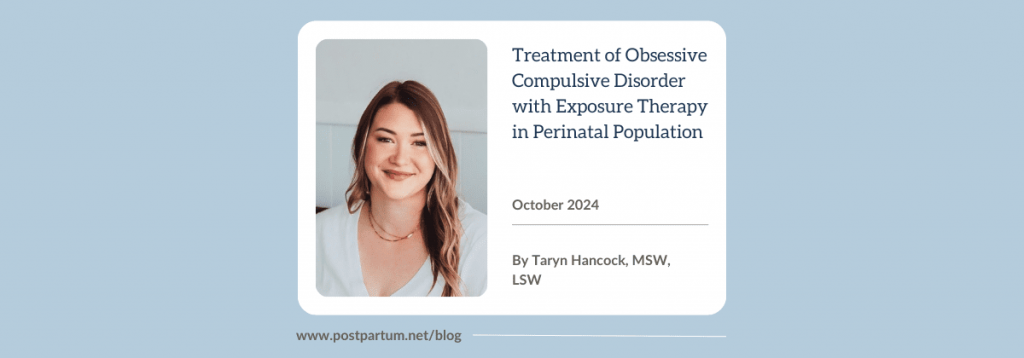By Taryn Hancock, MSW, LSW
One of the most transformative times in a human’s life is becoming a parent. The time of conception to the birthing experience to the lesser-known “fourth trimester” can bring an array of emotions. Whether you are a birthing parent, a partner, a loved one, or a provider, recognizing how to support someone experiencing OCD is the first step in treating Perinatal Obsessive-Compulsive Disorder.
My goal as a clinician is to educate and bring awareness to how OCD can impact a person within the perinatal period. OCD does not discriminate and can occur in the most unlikely of situations. OCD can be complex whether someone is outwardly engaging in physical compulsions or inwardly facing a mental battle; it is unique to each person’s triggers and behaviors.
What is Perinatal OCD?
Perinatal OCD is best described as a diagnosis of obsessive-compulsive disorder during the perinatal period. The perinatal period refers to the period during pregnancy and up to three years postpartum.
Perinatal OCD consists of a cycle of obsessions that present as unwanted thoughts, images, or impulses that occur repeatedly, causing significant distress for the person. Due to the intensity and frequency of the obsessions, people experience a range of emotions and tend to engage in compulsions, which are best described as repetitive behaviors or thoughts to try and reduce the distress around the obsessive thoughts and provide themselves with temporary relief.
Examples of obsessions and compulsions can constitute as the following:
Obsessions
Intrusive thoughts
— harm thoughts
— sexual thoughts
Contamination
Perfectionism
Fear of losing control
Scrupulosity
— religious-based thoughts
SIDS/Sleep
Compulsions
Reassurance-seeking
Checking
Replacing/neutralizing the distressing thought
Excessive washing/cleaning
Ordering
Research
Avoidance
Counting/Tracking
Rigid routines
Rumination
It is important to note that anything can be an obsession and a compulsion and to be aware of what ways a person is trying to achieve relief in the form of repetitive behaviors, rumination, or distraction. OCD manifests in many ways and looks vastly different from person to person.
Treatment for OCD
While there are multiple modalities of treatment and interventions, I want to focus on Exposure Response and Prevention Therapy (ERP) as treatment for both complex anxieties and OCD as it is the gold standard and evidence-based treatment for such diagnosis. Exposure Therapy is the idea that if we purposefully exposure ourselves to the feared stimuli such as a person, place, thought, mental image, or bodily sensation it will typically elicit emotions such as anxiety, fear, shame, and guilt that cause a person to engage in both physical and mental compulsions or rituals.
There are different types of exposures:
Imaginal – Uses imaginal imagery of the feared stimuli, creating a worst-case scenario. This can include a narrative about the feared stimuli or audio recordings of triggering statements.
In Vivo – These are real-life exposures where we confront the feared stimuli in a planned and structured way.
Interoceptives – This type of exposure recreates the physiological symptomology of a panic attack that can be associated with extreme distress from OCD. Panic-like symptoms are mimicked to habituate and tolerate the discomfort.
You can use a combination of these types of exposures as a person begins to build their distress tolerance around exposure work and decrease safety-seeking behaviors. Four key guidelines while engaging in any exposure are as follows:
1. Specific – You want your exposure to be specific and as clear as possible.
2. Plan – You want to design, discuss, and plan your exposure. *Occasionally, real-life, unplanned exposures occur and we learn to cope with those as they come.
3. Time Limited – Set your expectations for no longer than an hour.
4. Recovery – Allow time for recovery and reflection and use this time to build evidence that supports that OCD can be challenged.
Planning Exposure Treatment
To start curating your treatment plan for ERP, you will have your client create what is called an exposure hierarchy. This will serve as a guide for treatment and a roadmap to combat compulsions. The person will create a list of feared stimuli and rank it by the level of distress it causes. An example of this would be a client listing giving a baby a bath as a feared stimulus due to obsessions around death, fear of losing control, or fear of physical or sexual harm coming to the baby. The therapist and client will then begin to engage in planned exposures to increase distress, accept uncertainty, and resist compulsions. Based on the example stated above, the client will begin to engage in gradual exposures of listening to running bath water, writing a worst-case scenario about bath time, doing bath time accompanied by another individual, and eventually independently. Exposures will be unique to each client and will build upon each other to become more challenging and increase distress tolerance working towards habituation and inhibitory learning, both needed to rewire the brain to break free of the cycle of OCD.
It is natural to want to avoid what we fear and to bring ourselves a sense of comfort when we are distressed. This keeps us stuck in the cycle of OCD and unable to live a meaningful life free from compulsions and obsessions. By recognizing, accepting, and challenging OCD symptoms, you are working towards a life of being more present with those who matter most.
I would like to express my appreciation and thanks to my colleagues and mentors for their overall guidance and insight in this field which has made for an inspiring experience for me.
Learn More About Perinatal Mental Health Disorders
Get Help
Free Online Peer Support Groups
Chat with an Expert
Learn More About OCD and Different Subtypes
Additional Support Groups and Treatment Groups










